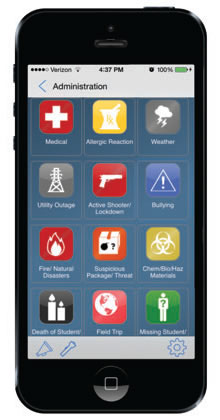Emergency Response App Enhances District Safety

SchoolDude’s CrisisManager mobile app allows Stonington district administrators to access critical safety information at the tap of a button.
Stonington Public Schools, a school district in southeastern Connecticut, was looking for a way to make emergency response information available instantly for teachers and staff. After much research and comparison, the district is now using SchoolDude’s CrisisManager, a mobile safety app.
Stonington Public Schools’ administrators have access to the CrisisManager mobile app, based on their respective school, which details instructions for emergency response scenarios including inclement weather, active shooter, bomb threat, student injury and other crisis situations. Teachers will begin using the app later this year.
“CrisisManager allows us to make important emergency information immediately available to our administrators on their smartphones and they in turn can connect with emergency personnel or report incidents as they arise,” says Ken Donovan, director of facilities and security, Stonington Public Schools. “In addition to meeting federal regulations, the mobile safety app helps us follow Connecticut’s school security and safety plan standards for reporting emergencies in a uniform manner.”
Previously, Stonington Public Schools relied on paper-based emergency response materials, which were difficult to find during a crisis and quickly became outdated once printed. Additionally, the school district’s annual incident reporting on lockdowns and drills involved paperbased tracking which was cumbersome. With CrisisManager, incident reporting is much easier for administrators and school safety personnel.
Stonington Public Schools’ customized CrisisManager mobile app offers one-tap emergency calling and the most up-to-date building maps, emergency exits and lockdown locations. Emergency plans, available with or without a Wi-Fi connection, are password-protected, and not available to the general public.
For the past 15 years, SchoolDude has served as the market leader in education enterprise asset management, delivering Software-as-a-Solution applications to help both small and large institutions better manage their facilities, IT and business operations. More than one million education professionals from more than 6,000 educational institutions are using SchoolDude to streamline a variety of critical processes.
www.SchoolDude.com
This article originally appeared in the issue of .